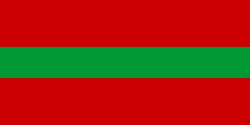 | |
| Use | Civil and state flag, civil and state ensign |
|---|---|
| Proportion | 1:2 |
| Adopted | 31 January 1952 |
| Relinquished | May 1990 |
| Design | Three horizontal bands of red, green and red, in a 3:2:3 ratio, charged in the canton with a gold hammer and sickle crowned by a gold-bordered, five-pointed red star |
 | |
| Use | Civil and state flag, civil and state ensign Three horizontal bands of red, green and red, in a 3:2:3 ratio |
The flag of the Moldavian Soviet Socialist Republic for most of its history was a horizontal triband of red, green and red, in a 3:2:3 ratio, charged in the canton with a gold hammer and sickle crowned by a gold-bordered, five-pointed red star. This was the SSR's second flag, adopted on 31 January 1952. [1]
Contents
The SSR's first flag was in use from 1940 to 1952. In 1990, the Romanian tricolor was briefly the SSR's flag before what would become the coat of arms of Moldova was added to the center. The resulting flag was retained when Moldova declared its independence the following year, in 1991.
The unrecognized state of Transnistria, which broke away from the rest of Moldova in 1990, retained the (second) flag of the Moldavian SSR and still uses it to this day.








